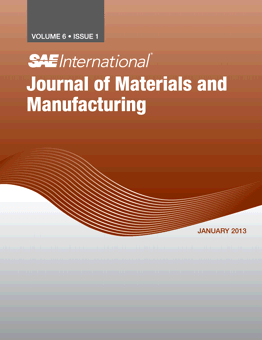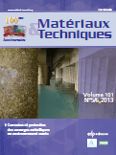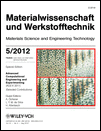
JOURNAL OF MATERIALS PROCESSING TECHNOLOGY
Scope & Guideline
Pioneering Research in Materials Processing Excellence
Introduction
Aims and Scopes
- Advanced Materials Processing Techniques:
The journal covers a wide range of advanced materials processing techniques, including additive manufacturing, laser processing, and welding methods, focusing on innovations that enhance material properties and processing efficiency. - Material Characterization and Performance Evaluation:
Publications in the journal often include studies on the characterization of materials at various scales, assessing their microstructure, mechanical properties, and performance under different processing conditions. - Interdisciplinary Applications:
Research published in the journal spans multiple disciplines, including aerospace, automotive, biomedical, and energy sectors, highlighting the versatility of materials processing technologies. - Emerging Technologies:
The journal is dedicated to exploring emerging technologies in materials processing, such as machine learning applications, real-time monitoring, and novel hybrid manufacturing techniques. - Sustainability and Eco-Efficiency:
A growing focus on sustainability is evident, with studies aimed at reducing waste, improving energy efficiency, and developing eco-friendly materials and processes.
Trending and Emerging
- Additive Manufacturing Innovations:
There is a significant increase in publications related to additive manufacturing, focusing on novel materials, improved printing techniques, and applications in complex geometries, particularly in aerospace and biomedical fields. - In-Situ Monitoring and Control:
Research exploring in-situ monitoring techniques during processing, such as real-time imaging and sensor integration, is on the rise, reflecting a growing interest in process control and quality assurance. - Hybrid Processing Techniques:
Emerging methodologies that combine multiple processing techniques (e.g., laser and ultrasonic) to enhance material properties and processing efficiency are gaining traction, indicating a trend towards more integrated approaches. - Sustainability and Green Manufacturing:
A notable trend is the increasing focus on sustainable processing methods, including waste reduction, energy-efficient practices, and the use of eco-friendly materials, aligning with global sustainability goals. - Machine Learning and AI Applications:
The integration of machine learning and artificial intelligence in materials processing is becoming a prominent theme, with studies aimed at optimizing processes, predicting material performance, and automating manufacturing workflows.
Declining or Waning
- Traditional Machining Processes:
Research related to conventional machining processes appears to be declining as the focus shifts towards advanced and hybrid processing techniques that offer greater efficiency and capabilities. - Basic Material Properties Studies:
There is a noticeable reduction in publications solely focused on basic material properties without a strong connection to processing techniques or applications, indicating a preference for studies that integrate processing with performance. - Low-Temperature Processing Techniques:
Interest in low-temperature processing methods may be waning, as more researchers explore high-temperature and advanced techniques that enhance material properties and processing speed. - Standardized Testing Methods:
The journal has seen a decrease in studies that solely focus on standardized testing methods for materials, as the emphasis shifts towards innovative and tailored testing approaches that provide deeper insights into material behavior.
Similar Journals

Journal of Manufacturing and Materials Processing
Unlocking the Future of Industrial EngineeringThe Journal of Manufacturing and Materials Processing is a premier *open access* journal published by MDPI since 2017, located in Switzerland. This scholarly publication provides a vital platform for sharing cutting-edge research in the fields of industrial and manufacturing engineering, mechanical engineering, and mechanics of materials. With an impressive categorization ranking in the Q2 quartile for these disciplines as of 2023, this journal not only enhances the global discourse in manufacturing and materials processing but also showcases significant contributions from researchers worldwide. Its robust positioning in Scopus rankings—placing 118th in Industrial and Manufacturing Engineering and 179th in Mechanical Engineering—underscores its impact and relevance in the academic community. As a *fully open access* journal, it ensures that all research is readily accessible, promoting greater dissemination of knowledge and fostering collaboration among scientists, engineers, and industry professionals. This makes the Journal of Manufacturing and Materials Processing an essential resource for anyone invested in the advancements of material technology and manufacturing processes.

JOURNAL OF CERAMIC PROCESSING RESEARCH
Elevating Knowledge in Ceramic Processing ExcellenceJOURNAL OF CERAMIC PROCESSING RESEARCH, published by the Korean Association for Crystal Growth, Inc., serves as a vital source of scholarly communication in the field of ceramics and composites. With an ISSN of 1229-9162, this well-regarded journal aims to advance knowledge through rigorous research and publication of innovative studies that push the boundaries of ceramic processing technologies. Indexed in Scopus and boasting a 2023 Q3 ranking in the ceramics category, it provides a platform for researchers to disseminate their findings and engage with emerging trends in material science. The journal reflects a commitment to contributing to the scientific community, emphasizing the importance of interdisciplinary collaboration and advancements in fabrication techniques. Although it operates under a traditional access model, the journal is a beacon for researchers, professionals, and students, inviting them to explore breakthroughs from the years 2000 through 2024 and beyond.

JOURNAL OF ENGINEERING MATERIALS AND TECHNOLOGY-TRANSACTIONS OF THE ASME
Elevating the discourse on materials technology and its impact.JOURNAL OF ENGINEERING MATERIALS AND TECHNOLOGY-TRANSACTIONS OF THE ASME is a premier journal published by the American Society of Mechanical Engineers (ASME), dedicated to advancing the field of engineering materials and technology. With an ISSN of 0094-4289 and E-ISSN 1528-8889, this journal has provided invaluable insights since its inception in 1973. Operating from its headquarters in New York, United States, it serves a global audience of researchers, professionals, and students alike. The journal is recognized for its rigorous peer-review process and its commitment to disseminating high-quality research, currently holding a Q3 quartile ranking across multiple categories including Condensed Matter Physics, Materials Science, Mechanical Engineering, and Mechanics of Materials. With a focus on exploring innovative materials and their applications, it aims to foster collaboration and discovery in the engineering community. Although it is not an open-access journal, it continues to play a vital role in shaping the future of engineering materials research up to 2024. Researchers and practitioners will find in this journal a significant platform to support the development and understanding of engineering materials, making contributions that resonate through academia and industry.

Acta Metallurgica Slovaca
Advancing metallurgical knowledge for a sustainable future.Acta Metallurgica Slovaca is a distinguished open-access journal published by SCICELL SRO that has been pivotal in the field of Materials Science and Metallurgy since its inception. With a robust commitment to disseminating high-quality research, this journal covers a wide array of topics within the scope of metals and alloys. Now indexed in Scopus, it ranks 82nd out of 176 in its category, reflecting a growing influence within the scientific community. With a quartile ranking of Q3 as of 2023, Acta Metallurgica Slovaca serves as an essential platform for researchers and professionals seeking to share innovative findings and developments in metallurgical science. Open access since 2013, it ensures that research is accessible to all, fostering collaboration and engagement across academia and industry worldwide. With a converged publication timeline extending from 2009 to 2024, this journal continues to play a crucial role in advancing knowledge and addressing contemporary challenges in the metallurgy sector.

Materiali in Tehnologije
Exploring the Frontiers of Material TechnologiesMateriali in Tehnologije is a distinguished peer-reviewed journal dedicated to the field of materials science, focusing specifically on metals and polymers. Published by the Institute for Metals and Materials Technology in Slovenia, this open-access journal has been at the forefront of disseminating research findings and innovative technologies since 2000. With a current impact factor that reflects its increasing visibility in the academic community, Materiali in Tehnologije serves as an invaluable resource for researchers, professionals, and students alike, encompassing a wide array of studies in the categories of Metals and Alloys, as well as Polymers and Plastics. The journal is indexed in Scopus, highlighting its relevance and contribution to the field, particularly with its ranks of Q3 in Metals and Alloys and Q4 in Polymers and Plastics. As it converges towards 2024, Materiali in Tehnologije continues to be a pivotal platform for knowledge exchange, encouraging advancements in materials research and technology.

AMERICAN CERAMIC SOCIETY BULLETIN
Fostering Excellence in Ceramic ScienceAMERICAN CERAMIC SOCIETY BULLETIN, published by the American Ceramic Society, serves as a pivotal publication in the field of ceramics and composites, highlighting research and advancements from 1969 to 1990, and resuming from 1993 to 2019, with a focus on the ongoing developments anticipated in 2023 and beyond. With an ISSN of 0002-7812 and an E-ISSN of 1945-2705, this journal stands out in its category, earning a respectable Q2 rank in the 2022 quartile rankings for Materials Science. Although not Open Access, its content remains essential for researchers, professionals, and students dedicated to exploring innovative materials and their applications. The journal's commitment to disseminating quality research fosters an informed community that drives the evolution of ceramics and composites, ensuring its readers stay at the forefront of this dynamic field.

JOURNAL OF THERMOPLASTIC COMPOSITE MATERIALS
Exploring Breakthroughs in Thermoplastic ApplicationsJOURNAL OF THERMOPLASTIC COMPOSITE MATERIALS, published by SAGE PUBLICATIONS LTD, is a cutting-edge journal dedicated to advancing the field of thermoplastic composites and their applications within ceramics and condensed matter physics. With an ISSN of 0892-7057 and an E-ISSN of 1530-7980, the journal boasts a strong academic reputation evidenced by its impressive impact factor as well as its classification in the 2023 Q2 category for both Ceramics and Composites and Condensed Matter Physics. Ranked #60 in Condensed Matter Physics and #26 in Materials Science by Scopus, the journal plays a pivotal role in disseminating innovative research findings, trends, and advancements to a global audience. Spanning research from 1988 to 2024, it serves as an essential resource for researchers, professionals, and students alike, fostering collaboration and promoting knowledge in the ever-evolving landscape of thermoplastic composite materials. Although currently not open access, the comprehensive content and critical insights provided by this journal are invaluable for those engaged in cutting-edge research and practical applications in these fields.

SAE International Journal of Materials and Manufacturing
Pioneering Discoveries in Materials and Manufacturing TechniquesSAE International Journal of Materials and Manufacturing, published by SAE International, is a leading peer-reviewed journal that focuses on the advancements and research in the fields of materials science and manufacturing engineering. With ISSN 1946-3979 and E-ISSN 1946-3987, this journal is an essential resource for researchers, professionals, and students who are keen on exploring innovative materials and modern manufacturing techniques. Although the journal currently does not offer open access options, its rigorous selection process ensures the publication of high-quality papers that contribute significantly to the knowledge base in the industry. Recognized within the third and fourth quartiles across various engineering categories, including Industrial and Manufacturing Engineering and Mechanical Engineering, the journal provides an impactful platform for disseminating groundbreaking research. With a converged history since 2002 and a comprehensive approach to critical topics in mechanics of materials, it empowers the academic community with vital insights, trends, and methodologies that propel the future of manufacturing excellence.

Materiaux & Techniques
Bridging Theory and Application in Material TechnologiesMateriaux & Techniques, published by EDP SCIENCES S A, is a prominent journal in the field of materials science, specifically focusing on diverse and innovative techniques in material development and application. With an ISSN of 0032-6895 and an E-ISSN of 1778-3771, this French journal serves as a key resource for researchers and professionals looking to advance their knowledge and share their findings within the community. The journal holds a Q3 ranking in Materials Science (miscellaneous), indicating its role in contributing to various facets of material science research amidst a growing field. Despite operating under a traditional access model, it provides a platform for rigorous peer-reviewed studies and significant advancements in material technology. With a publication history tracing back to the late 1970s and extending through to 2024, Materiaux & Techniques continues to uphold its commitment to fostering high-quality discourse and innovation in materials science.

MATERIALWISSENSCHAFT UND WERKSTOFFTECHNIK
Advancing Knowledge in Material Engineering.MATERIALWISSENSCHAFT UND WERKSTOFFTECHNIK, published by WILEY-V C H VERLAG GMBH, is a prominent journal dedicated to the field of materials science and engineering. With its ISSN 0933-5137 and E-ISSN 1521-4052, this journal serves as a vital resource for researchers and professionals engaged in exploring the intricate relationships between the properties of materials and their applications. Established in 1970 and continuing through 2024, the journal has been consistently recognized in various categories, achieving a Q3 ranking in 2023 across Condensed Matter Physics, Materials Science (miscellaneous), Mechanical Engineering, and Mechanics of Materials. Although it does not offer open access, its high-quality peer-reviewed content is fundamental to the advancement of knowledge within its three key areas: novel material development, material characterization, and application of materials in engineering contexts. As a driving force in the scientific community, MATERIALWISSENSCHAFT UND WERKSTOFFTECHNIK continues to cater to the curiosity of aspiring students, seasoned professionals, and researchers alike, facilitating a deeper understanding of the complexities of material technology.